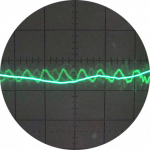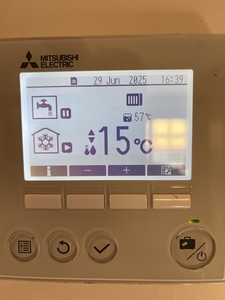Mitsubishi cycling while on chilled water output
We have our Mitsi 14kW Zubadan on light cooling during hot weather. The flow temp is set to 15C on the controller to avoid condensation problems.
Today I noticed that the unit is cycling every few minutes because it is chilling down to around 12.5C and then turning off. The return temp is around 19C and seems fairly consistent.
Not sure if it makes a difference but I have a 100 litre 4 pipe buffer but very little other volume as all Jaga fancoil rads - perhaps this volume is too small for the ASHP?
Anyway, is it possible to reduce the cycling?
Mitsubishi Zubadan 14kW with Mixergy 210l DHW in 220m2 barn property. 24 solar panels = 9kWp with GivEnergy 5.0kW Hybrid inverter and 19kWh GivE batteries. Jaga Strada fan-assisted rads throughout. Landvac vacuum glazing/triple glazed windows.
Sorry to start with the obvious but are the radiators getting cold and are the fans on.
Heat pumps cycle when cooling for the same reason as they cycle when heating, insufficient load. Also I wonder how a 4port buffer works when cooling, it's possible that most of the incoming cold water falls to the bottom and returns to the heat pump, while most of the incoming warm water rises to the top and returns to the radiators (which is one reason why I ask whether they are getting cold)
Assuming the rads are working at full fan and getting cold (it's worth checking the flow temp to the rads from the buffer) then it's cycling because the load is less than the min output. Not much can be done about this other than a volumiser which will increase the cycle time but with about the same on/off ratio.
4kW peak of solar PV since 2011; EV and a 1930s house which has been partially renovated to improve its efficiency. 7kW Vaillant heat pump.
@jamespa yes the rads are getting cold and the fans are on - but not 15C cold - more like 17C with a return of 19C.
I think the buffer operation point is a good one - that could explain the cycling.
The buffer is of course in a (currently) very hot loft space which won't help matters.
Mitsubishi Zubadan 14kW with Mixergy 210l DHW in 220m2 barn property. 24 solar panels = 9kWp with GivEnergy 5.0kW Hybrid inverter and 19kWh GivE batteries. Jaga Strada fan-assisted rads throughout. Landvac vacuum glazing/triple glazed windows.
I think that explains it. Unless you can somehow increase load or system volume I think you are stuck with the cycling, unless of course others can suggest something. Bypassing the buffer will probably help but of course that's major surgery.
4kW peak of solar PV since 2011; EV and a 1930s house which has been partially renovated to improve its efficiency. 7kW Vaillant heat pump.
Is the power consumption worrying you or are you just concerned about the cycling on principle?
2kW + Growatt & 4kW +Sunnyboy PV on south-facing roof Solar thermal. 9.5kWh Givenergy battery with AC3. MVHR. Vaillant 7kW ASHP (very pleased with it) open system operating on WC
@judith not power consumption just the overall efficiency of operation and wear and tear which I imagine is bad for the HP?
At the moment power is from solar panels - although I can export surplus so I suppose there is a cost...
Mitsubishi Zubadan 14kW with Mixergy 210l DHW in 220m2 barn property. 24 solar panels = 9kWp with GivEnergy 5.0kW Hybrid inverter and 19kWh GivE batteries. Jaga Strada fan-assisted rads throughout. Landvac vacuum glazing/triple glazed windows.
Posted by: @downfield@judith not power consumption just the overall efficiency of operation and wear and tear which I imagine is bad for the HP?
Yes, but hopefully only for a few days of the year. If you wanted cooling more frequently I would be concerned about the effect of the cycling on compressor lifetime in which case you might want to consider adding a largeish volumiser (and deleting the buffer tank!)
4kW peak of solar PV since 2011; EV and a 1930s house which has been partially renovated to improve its efficiency. 7kW Vaillant heat pump.
@downfield I don't know how your fan coils are plumbed in but all the conventional radiators I've come across are connected to flow and return at the bottom of the radiator which i assume helps with heat dispersion as the hot water will flow in and gravitate to the top of the radiator and the cooler water to the bottom to be pushed out to the return circuit. Applying the same kind of logic (but in reverse) if using a conventional radiator to cool using chilled water you would require the radiators to be plumbed with inlet and outlet at the top if you want any significant kind of cooling capacity from them, surely? How do you fan coils overcome the physics of hot water rising and cooler water falling?
@iaack they have a finned emitter at the bottom a bit like a car radiator so the water runs horizontally through those. Most of the rad is empty but its purpose is to provide a chimney effect so they can work for heating without fans. But for cooling they have a row of fans sitting just above the coils.
Mitsubishi Zubadan 14kW with Mixergy 210l DHW in 220m2 barn property. 24 solar panels = 9kWp with GivEnergy 5.0kW Hybrid inverter and 19kWh GivE batteries. Jaga Strada fan-assisted rads throughout. Landvac vacuum glazing/triple glazed windows.
@downfield With a car radiator the hot water from the engine is piped to the top of the radiator and the cooled water is drawn off from the bottom. The height of the radiator typ. 45 cm so inlet is approx 50 cm above the outlet. Are your inlet and outlet pipes at the same height or is one higher than the other?
@downfield I thought I'd quiz ChatGPT about this and answer is as follows (specifically point 3):
Yes, you should plumb a domestic fan coil radiator differently if you plan to use it for cooling (in addition to or instead of heating). Here's why and how:
---
🔧 Key Plumbing Considerations for Cooling
1. Condensate Drainage
Cooling produces condensation on the coil (especially if chilled water is below dew point).
You must install a condensate tray with a gravity or pumped drain to remove collected water and prevent leaks or mold.
2. Pipe Insulation
Cold water pipes can sweat due to condensation.
Use closed-cell insulation (e.g., Armaflex) on all chilled water supply and return lines.
3. Flow Direction
Coil performance is better with counterflow configuration:
Chilled water enters at the bottom (opposite side to air outlet).
This enhances heat transfer and reduces risk of air locks.
For heating, flow is often top-down, so you may need to reverse the flow direction for cooling.
4. Control Valves and Sensors
Install a 2- or 3-port motorized valve for temperature control.
Use a thermostat with cooling mode or BMS integration for proper modulation.
Consider an aquastat or condensation sensor to prevent coil freezing or excessive condensation.
5. Pump Sizing and Flow Rates
Cooling circuits generally require higher flow rates than heating due to lower ΔT.
Check the fan coil's pressure drop and match with pump performance accordingly.
6. Air Bleeding
Ensure there’s an automatic air vent at the high point.
Cooling loops are more prone to airlocks due to denser water.
---
Optional: Reversible Systems
If you plan to use the radiator for both heating and cooling, ensure:
It's designed for dual-mode operation.
You use reversible valves and proper thermostatic controls.
Materials are suitable for condensation resistance and thermal cycling.
Your emitters will be less than 50% efficient, radiators are emitters not absorbers, cooling is absorbing heat not emitting cooling in reverse (so to speak) the surface of the rad becomes a chilled surface, cool air drops to the floor and limited heat convects through the surfaces due to its low level. Using a 14kW system in cooling against 6kW or less of chilled surface will not work very well.
Not to mention the DT, if the room is 30 and the flow is 17 /19 (M18) = (30-18=12 Rad DT) where your system on heating would have been designed closer to RoomDT 25 on heating assuming target room temp 20 flow (M42.5)
So you have half the performance on half efficient radiators. Ecodan do FCU's that can overcome this but you must vapour seal the pipework and have a drain, run the system at 12 Deg C to get your DT to target 10 on the FCU, or a raised 18 DT assuming a room temp of 30 deg c. You need the forced air across the coil to help the system absorb more heat and remove it from the building, its exactly why there is a fan on the external unit to absorb the heat from outside when in heating.
Happy cooling 🙂
AAC Group Ltd covering the Kent Area for design, supply and installation of ASHP systems, service and maintenance, diagnostics and repairs.
Professional installer. Book a one-to-one consultation for pre- and post-installation advice, troubleshooting and system optimisation.
- 26 Forums
- 2,364 Topics
- 53.6 K Posts
- 224 Online
- 6,029 Members
Join Us!
Worth Watching
Latest Posts
-

How long will your energy contract last?
Some heat pump tariffs don’t run as long as a heat pu...
By Toodles , 3 hours ago
-

@morgan They are unsupervised these days, can’t get the...
By Toodles , 3 hours ago
-
-
RE: Octopus Cosy Heat Pump Owners & Discussion Thread
@kevh it's worth remembering that many lsvs only actual...
By JamesPa , 1 day ago
-

RE: Setback savings - fact or fiction?
Exactly. We only need to compare conditions, to decide ...
By cathodeRay , 1 day ago
-
RE: Balancing financial efficiency and comfort using the Octopus Cosy tariff
I found because I have very low heat loss I can set bac...
By RadWhisperer , 1 day ago
-
RE: Need Help Optimising My Rushed ECO4 Install: 12kW Bosch Heat Pump
Welcome @mickamills We too have an oversized 12kW Sa...
By Old_Scientist , 2 days ago
-
RE: My Powerwall 3 Consumes 3-4 kWh/Day in Self-Consumption: Is This Normal?
@caron I can confirm that the power usage of the PW3 is...
By Old_Scientist , 2 days ago
-
RE: Speedcomfort radiator fans
Thats true, but having tried (and succeeded) in constru...
By JamesPa , 2 days ago
-
RE: Solis S6-EH1P8K-L-PLUS – Why I Chose It and What I’ve Learned So Far
@bash brilliant, thanks for the feedback
By energy9165 , 2 days ago
-

RE: Heat Pump Heats the House… But It’s Not Cosy. Emitter Changes or System Tweak?
@alastair There I was, feeling grumpy, he said “Cheer u...
By Toodles , 2 days ago
-
RE: Grant Aerona: Is there a setting to keep the 2-port valve open during pump blockade
Depends on OAT. Mine cycles at OAT>10 and of course...
By JamesPa , 2 days ago
-
RE: New Fogstar 15.5kWh upright solution
@transparent My conclusion is as you have noted, tha...
By Bash , 2 days ago
-
RE: Mitsubishi Ecodan R290 10kW performance
And to you too. Wishing you a very enjoyable festive s...
By Sheriff Fatman , 2 days ago
-

RE: External pipework insulation
They do? But that isn't apparent from the photos we'r...
By Transparent , 2 days ago
-

RE: Say hello and introduce yourself
@velcro welcome to the forums. Please feel free start a...
By Mars , 3 days ago
-
Daikin EDLA11D3V3 DHW Settings
I have a newly installed EDLA11D3V3 which I'm still get...
By Velcro , 3 days ago
-
RE: Midea ASHP – how to set weather compensation
@curlykatie did you get sorted with this?
By MickaMills , 3 days ago
-
RE: MyVaillant Connect Regular Disconnect
Thanks. Yes, if the time is consistently 11pm every nig...
By buckwem , 4 days ago






